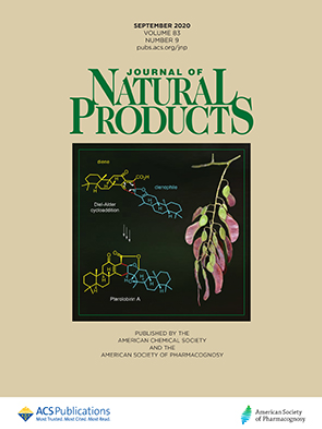LC-MS Guided Discovery and Biosynthetic Pathway of Coprisamides E-H, Cinnamic Acid-Containing Metabolites from the Marine Algae-Derived Streptomyces thermolineatus NAK03196.
IF 3.3
2区 生物学
Q2 CHEMISTRY, MEDICINAL
Journal of Natural Products
Pub Date : 2025-03-28
Epub Date: 2025-03-03
DOI:10.1021/acs.jnatprod.4c01439
引用次数: 0
Abstract
Four cinnamoyl-containing nonribosomal peptides (CCNPs), coprisamides E-H (1-4), were isolated from the marine algae-associated actinomycete strain Streptomyces thermolineatus NAK03196. Their structures were elucidated to be unreported coprisamides by comprehensive analyses of HRESIMS, 1D and 2D NMR spectroscopic data, Marfey's method, and MS/MS analysis. Coprisamides E (1) and F (2) bear a characteristic nonproteinogenic amino acid, 2,3-diaminopropanoic acid. The biosynthetic pathways for these isolates were proposed through a comparison of their biosynthetic gene clusters with reported homologous gene clusters. Coprisamide E (1) exhibited weak antibacterial activity against the Gram-positive strain Staphylococcus aureus.
求助全文
约1分钟内获得全文
求助全文
来源期刊
CiteScore
9.10
自引率
5.90%
发文量
294
审稿时长
2.3 months
期刊介绍:
The Journal of Natural Products invites and publishes papers that make substantial and scholarly contributions to the area of natural products research. Contributions may relate to the chemistry and/or biochemistry of naturally occurring compounds or the biology of living systems from which they are obtained.
Specifically, there may be articles that describe secondary metabolites of microorganisms, including antibiotics and mycotoxins; physiologically active compounds from terrestrial and marine plants and animals; biochemical studies, including biosynthesis and microbiological transformations; fermentation and plant tissue culture; the isolation, structure elucidation, and chemical synthesis of novel compounds from nature; and the pharmacology of compounds of natural origin.
When new compounds are reported, manuscripts describing their biological activity are much preferred.
Specifically, there may be articles that describe secondary metabolites of microorganisms, including antibiotics and mycotoxins; physiologically active compounds from terrestrial and marine plants and animals; biochemical studies, including biosynthesis and microbiological transformations; fermentation and plant tissue culture; the isolation, structure elucidation, and chemical synthesis of novel compounds from nature; and the pharmacology of compounds of natural origin.

 求助内容:
求助内容: 应助结果提醒方式:
应助结果提醒方式:


